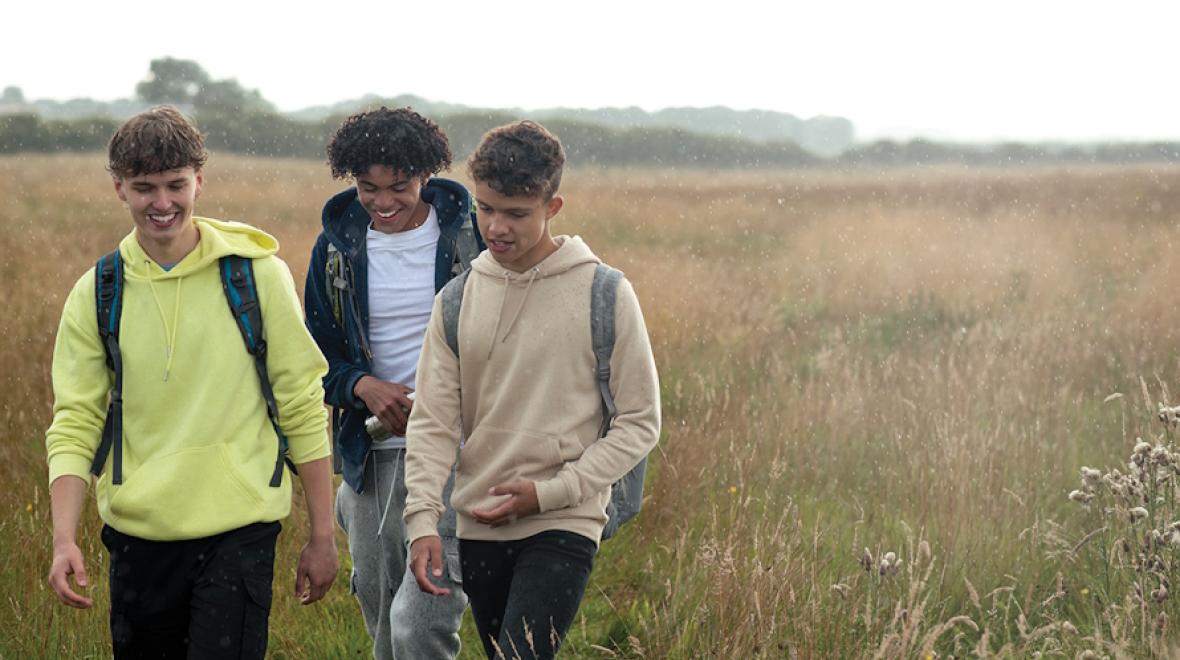
My family therapy sessions dealing with teen mental health and social media concerns tend to go something like this: Mom says Sarah’s eighth grade academic slump, depression and withdrawal from activities are due to her social media addiction; Dad worries about Sarah’s suicidal thoughts and isolation; and Sarah claims that going online is her only way of coping with stress. Without it, she says, she’d explode.
Teens tumble down their own unique rabbit holes into a mental health crisis, but one common factor parents blame for their descent is “screen addiction.”
While we can quibble about the word “addiction,” when kids spend almost every waking hour scrolling through media instead of engaging in emotionally healthy academic, physical and social activities, it’s hard not to focus on phones as the problem.
But what many tweens and teens like Sarah have is a life problem, not just a phone problem. They need what I call a REFRESH intervention.
The REFRESH basics:
R - Restful sleep
E - Essential nutrition
F - Fitness and exercise
R - Recreational fun
E - Enhanced relationships IRL
S - Stress-reduction strategies
H - Healing time in nature
|
For more support and resources surrounding the youth mental health crisis, screen time and social media, and the importance of play, visit ParentMap’s Antidote for the Anxious Generation page. |
Beyond therapy: Calling for a ‘Green Space Agenda’
One response to address the spiraling mental health crisis among teenagers is to hire more therapists (like me). Good idea! But focusing exclusively on what therapists can do to influence REFRESH goals in one hour a week is a limited view.
It’s more prudent to use a wide-angle lens to look at youth health problems. Kids spend on average seven hours a day at school. By far, most report that school is the source of their greatest stress. And since stress is best treated at its roots, school is a great place to seed REFRESH solutions — and not just by addressing each student’s experience in the 1:1 setting of the counselor’s office.
What I propose: Schools need to employ a radical “Green Space Agenda” to enhance teen mental health — by expanding, as the name suggests, access to green spaces during school hours. This agenda would be a quadruple-hitter for punching those REFRESH buttons: Healing time spent in nature provides opportunities for stress reduction, physical activity, fun and positive in-person socializing.
Decades of research have indisputably shown that exposure to green spaces positively impacts the physical and mental well-being of children and teenagers. Study after study shows that nature exposure is associated with better academic performance, reduced stress levels, enhanced mental health and better social relationships. Enjoying recreation outside releases endorphins (the “feel good” neurotransmitters that provide relief from pain and stress), encourages face-to-face interactions and enhances brain functionality. By stepping away from screens and immersing ourselves in the beauty of nature, people of all ages can find respite from life pressures.
Stress-reduction strategies
Our sympathetic nervous system is the “fight or flight” neural circuit which registers our stress. It releases adrenaline and stress hormones in reaction to a perceived threat. When in high gear, physiological arousal may activate overwhelming anxiety, negative emotions and extreme thoughts, effectively shutting down learning, creativity and positive relating.
Surveys conducted over the past decade reveal that daily stress levels among teens are at an all-time high. Even kids with genius IQs can be so crippled by performance anxiety that they choke and bomb on tests and writing assignments.
Ideally, all kids would have a toolbox of skills for reducing the stress that spikes with the academic, emotional and social slings and arrows of the day. Recess time at school has traditionally been associated with play and physical activity, and it’s a rare student who doesn’t find time outside in the unmatched stress-busting power of nature to be restorative. Other self-calming techniques kids can employ include mindfulness practices, creating art and talking to friends.
The power of social relationships
Teens make friends, lose friends and suffer from the lack of friends at school. During the pandemic, many students — especially marginalized kids who were already struggling with academic and social problems — were glad to have their school shut down. Escaping social pressure, anxiety and aversive experiences felt good initially, until the problems got worse.
Apart from peer interactions, remote schooling disconnected students from essential in-person relationships with teachers, coaches and other adult mentors. It also removed them from opportunities to build social and emotional resilience. Academics and friendships withered, and access to social media mushroomed.
Motivation for peer contact surges in middle school, and so does self-consciousness. Pubertal and brain changes elicit intensely negative and positive emotions during early adolescence. Since impulse-control capacity is not fully developed until the mid-20s, adolescent passions are often unleashed, especially in contexts with no adult supervision. Rambunctious social drives can bring trouble to playgrounds — of both offline and online varieties.
Teen desires to seek social connection and inclusion make them especially vulnerable to the lures of social media. Lurking, texting and posting on social media is a lot easier than making conversation in real life. As a result, conversation skills are rapidly becoming a lost art. Teens don’t even want to talk on phones anymore.
Social anxiety is common. Conversation involves interpreting facial expressions, forming coherent sentences and figuring out the dance of mutually satisfying dialogue. For some, the mere idea of trying to make new friends IRL shoots their stress level into the flood zone.
No wonder parents are promoting the Wait Until 8th policy. This campaign encourages caregivers to delay children’s access to social media until eighth grade. Without smartphones until eighth grade, kids are impelled to make friendships the old-fashioned way — in person.
Growing concerns about the effects of social media
With the recent publication of the U.S. Surgeon General’s Advisory on Social Media and Youth Mental Health, the downsides of excessive social media use are front-page news. While teenage sexual activity, drug use and drunk driving have decreased over the past decade, risks in the online world have proliferated.
Much like a car, social media can take youths to lots of new places, but it can also be destructive, even lethal. In private and impulsive moments, teens download pornography, develop illicit relationships with strangers and interact in socially inappropriate ways that they would never conceive of doing offline. And even though social media can be used for positive connections, it can also be the source of social cruelty, disinformation, self-harm encouragement and spiraling negative emotions.
Social development is a key part of adolescence. Especially in the tween and early teen years, kids need guardrails and oversight, offline and online. As messy as the schoolyard can be, it is a good place for friends to be together and practice socializing — without phones.
Fitness and exercise
Exercise is known to be one of the most important building blocks of our physical and mental health. But like essential nutrition and sleep, it requires motivation, opportunity and adult support. Advantaged families arrange for after-school sports and weekend outings, but many families lack the neighborhood parks, economic resources and means to prioritize a focus on fitness for their teens.
As much as school sports are promoted for youth fitness, most kids do not participate, and those who do often quit by age 11. Competitive youth sports can be intimidating, exclusive — and expensive. Many kids report that by middle school, organized sports just aren’t fun anymore. And then there is a huge swath of tweens and teens who are uncomfortable in their bodies and feel humiliated by fitness metrics and social comparison. Combine all of these factors, and it is no wonder that 75 percent of teens are not getting the recommended 60 minutes per day of physical activity.
Expanding physical education programs and offering a wider range of options for school sports are both good ways to improve teen health, but playfields can also be used in more imaginative ways during the school day.
Maybe we can’t reach the goal of Finland’s policy, which sends students outside almost hourly, but we can certainly try to give our tweens and teens more breaks during the day to move their bodies, clear their heads and breathe fresh air.
The healing power of nature
Connection with natural beauty is associated with increased positive emotions — awe, joy, wonder, happiness. Add some laughter with friends, physical activity and relief breaks from the classroom, and you have a pretty good recipe for generating positive emotions.
Natural light is underrated. Not only does it stimulate the production of vitamin D in our bodies, but it plays a crucial role in mood regulation. It also helps regulate our body’s circadian rhythm, enhancing sleep patterns and overall well-being.
Being outside in nature has even been found to help reduce worrying. Repetitive negative thinking, which is called rumination, has been found to be an insidious aspect of depression. Since obsessive worry can become entrenched, sometimes the best strategy for relief is a physical reset. Getting that anxious teen outside to do a grounding exercise such as “name five things” can often be more effective at disrupting the worry loop than dispensing reassurance.
Teens take the lead
The Green Space Agenda will work best with a grassroots approach — meaning that teens need to lead the charge, with support from teachers, school administrators and parents.
Kindness clubs, peer counseling programs and suicide prevention projects have become common in middle and high schools. Student volunteers who want to address mental health, equity and social justice issues might be interested in leading the Green Space Agenda.
Environmentally minded students might also want to join in. Students have spearheaded initiatives at their schools to establish food gardens, promote solar panel installation and organize the planting of trees. Why not lead the mission to create more green space designated for student recreation and health promotion?
A key part of adolescent identity formation is seeking purpose in meaningful endeavors. Teens are also influenced by other teens, and the same social synergy that can spiral into risk can spiral into empathy, kindness and fun. Since the Green Space Agenda is about helping others feel less lonely, alienated and friendless, it offers a prime opportunity for student leaders to experience the “helper’s high.” Volunteering releases the feel-good hormones dopamine, oxytocin and serotonin.
The obstacles
The academic stakes for today’s students feel higher and more competitive than ever, with educational attainment representing a great determiner of who ends up in the “have” versus “have not” groups in our inequitable economic system. What parent doesn’t want to do everything they can to nudge their child’s odds to the high opportunity group? The problem is that those nudges turn into pushes, pressure, stress and mental health problems, all of which keep students from succeeding and excelling.
Without understanding what supports the mental health of students, it’s easy to think that allocating more space and time for the Green Space Agenda is an unnecessary, lightweight and fluffy indulgence. I confess: The reasons for not supporting the Green Space Agenda constitute a long list. The arguments against this agenda include economic factors, lack of space, maintenance, safety concerns, accessibility and competing priorities.
And it is true that schools are overwhelmed by many competing agendas. Parents, educators and other stakeholders want more school time and resources dedicated to STEM curriculum, arts and humanities programming, AP and honors courses, organized sports, mental health programs and health education, to name just a few.
Ultimately, resting, rejuvenating and rebooting teen brains and bodies with the Green Space Agenda would help bolster all of those school agendas. In the end, the Green Space Agenda requires people to understand that enhancing mental health through many vectors will result in vastly improved cognitive, social and emotional functioning.
The wide-angle lens on health and its components
A holistic view on adolescent health helps us to appreciate that most families with tweens and teens need support for enriching the REFRESH basics. Excessive use of social media and declining mental health are linked with the crumbling of those building blocks of health.
Disadvantaged parents struggle to get their marginalized students connected with sports, after-school activities, and safe and positive contexts for socializing. Schools can be a place to offer these students the REFRESH enhancers that they deserve.
But even the most affluent and privileged among us suffer from stress overload and mental health problems — sometimes even more than the average, due to academic pressures and unrealistic expectations. Virtually all students need ways to calm their anxious brains in order to thrive at school.
As philosopher Martin Buber once said, “Play is the exultation of the possible.” Getting our stressed-out students outside for recreational time in Mother Nature will unleash untold creativity, imagination and possibilities for positive social relationships.
Wait Until 8thEven before the U.S. Surgeon General released his recent advisory about the adverse effects of social media on youth mental health, parents were working overtime to limit kids’ screen time and protect them from the open waters of the internet. They knew what study after study has shown: Excessive time spent online poses significant risks to kids — and having a smartphone increases those risks. Which begs the question, what can parents do in a world of proliferating smartphone use among children? Wait Until 8th leverages the power of community so parents feel supported making responsible decisions regarding smartphone use for their kids. Parents pledge not to give their child a smartphone until eighth grade — here’s the powerful part — “as long as at least 10 families from your child’s grade and school pledge.” Banding together safeguards parents and kids from feeling pressured to get a smartphone too soon. Learn more and take the pledge at waituntil8th.org. |











